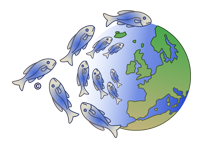

Polymastia boletiformis is a sponge forming a smooth, hemispherical cushion base reaching up to 10 cm in diameter. Many tube-shaped outgrowths, slightly conical and between 2 to 10 cm in height, emerge from the base and are ending with the oscules. Its colour is uniform but may vary : yellow, orange, ochre, gray or greenish.
There are other sponges of the genus Polymastia in the same geographical area. They all possess a basal cushion with
erected processes. Nevertheless, they are quite easily distinguishable:
Polymastia penicillus is clearer, with a dirty yellow colour. The base is often covered with sand and the tubules
are flattened, translucide and clearer than the base.
Polymastia agglutinans est de couleur jaune à rose orangé. La surface du coussinet est souvent recouverte de sable, et les
tubules sont très élancés.
Aaptos papillata is pale pink to purplish pink. The processes are paler, cylindrical and tip-rounded. The base is
often covered with sand.
Polymastia boletiformis is found from surface to depths down to 40 meters, in the Atlantic Ocean, the North Sea and the English Channel.
Source : World Register of Marine Species
Biota (Superdomain)
Animalia (Kingdom)
Porifera (Phylum)
Demospongiae (Class)
Heteroscleromorpha (Subclass)
Polymastiida (Order)
Polymastiidae (Family)
Polymastia (Genus)
Polymastia boletiformis (Species)
Oscule : opening generally quite visible, through which sponges expel water they have filtered to extract food particles.
Text : Wilfried Bay-Nouailhat © 2004 - 2025.
Photos : ©
Wilfried Bay-Nouailhat. Published with his kind permission.
Websites and reference works : Consult bibliography
Image satellite: © Esri, DigitalGlobe, GeoEye, Earthstar Geographics, CNES/Airbus DS, USDA, USGS, AeroGRID, IGN, and the GIS User Community.
Données de distribution : Polymastia boletiformis (Lamarck, 1815) in GBIF Secretariat (2019). GBIF Backbone Taxonomy. Checklist dataset https://doi.org/10.15468/39omei accessed via GBIF.org on 2025-10-16.
Source : World Register of Marine Species
Biota (Superdomain)
Animalia (Kingdom)
Porifera (Phylum)
Demospongiae (Class)
Heteroscleromorpha (Subclass)
Polymastiida (Order)
Polymastiidae (Family)
Polymastia (Genus)
Polymastia boletiformis (Species)
Oscule : opening generally quite visible, through which sponges expel water they have filtered to extract food particles.
Text : Wilfried Bay-Nouailhat © 2004 - 2025.
Photos : ©
Wilfried Bay-Nouailhat. Published with his kind permission.
Websites and reference works : Consult bibliography
Bay-Nouailhat W., april 2004, Description of Polymastia boletiformis, [On line] https://european-marine-life.org/02/polymastia-boletiformis.php, consulted on 2025 October 16.
Author

Plongeur - Naturaliste
Photographe Sous-Marin
© Mer et littoral 2004-2025 - All rights reserved
The texts and images on this website are not free of rights and cannot be copied and/or used without the agreement of their respective authors.